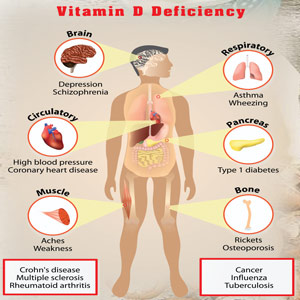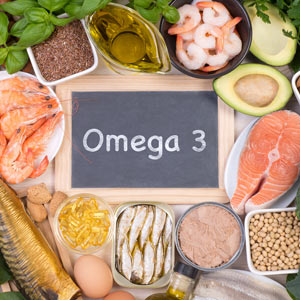Health: Key Nutritional Deficiencies among South Asians

Insufficient levels of Vitamin D and Omega fatty acids may be affecting your health.
Research has established that South Asians are more prone to certain health conditions like diabetes and heart disease than people from other communities. Our traditional diets, coupled with drastic lifestyle changes have contributed to this growing problem. Here, we examine two important micronutrients, Vitamin D and omega fatty acids, whose deficiency impacts the health of the South Asian community.
Vitamin D—The Sunshine Vitamin
Vitamin D is …a vitamin, isn’t it? Yes and no. Vitamin D plays a double role in our body—it’s stored in our fat cells as a vitamin and used in our body as a hormone. We need this vitamin for several crucial reasons:

• Vitamin D helps our bodies absorb calcium from food. Without sufficient biologically active vitamin D, bones lose calcium, becoming thin and brittle, resulting in osteoporosis, exercise injuries, fractures, frequent falls among elderly, and can lead to a disease called rickets in children. Research has associated vitamin D deficiency to depression, high blood pressure, type 2 diabetes, high cholesterol, depression, asthma, cardiovascular disease, cancer, autoimmune disorders, and polycystic ovary syndrome in women.
• The hormone vitamin D has other roles in
our body: aiding in cell growth, immune function, and decreasing aches and pains by reducing inflammation.
• A sufficient level of Vitamin D in the body may increase HDL, the “good” cholesterol that protects against heart disease and stroke.
• Vitamin D also decreases insulin resistance, helping people with prediabetes and diabetes.
We derive vitamin D3, cholecalciferol, from
two sources:
• Dietary sources (e.g. fortified dairy products, fatty fishes like salmon and sardines, red meat, fortified eggs). However, it’s key to note that if you are a vegetarian or eliminating egg yolks from your diet, you completely exclude your dietary intake of vitamin D3.
• Sunshine. Vitamin D3 is called the “sunshine vitamin.” When our bodies are exposed to sunrays, cholesterol in our skin absorbs UVB (ultraviolet B) radiation and converts it to D3.
How vitamin D3 works
Vitamin D2, the inactive form of vitamin D derived from plant based products like currently trending nondairy milks (soy, almond, coconut) or mushrooms or D3 (cholecalciferol) derived from above listed sources gets activated in our kidneys to form bioactive vitamin D called calcitriol. Calcitriol acts like a bus driver transporting dietary calcium to the small intestine for absorption. Calcium then enters the bloodstream and gets packed into our bones.
In summer, excess vitamin D3 can be stored in our fat cells in its inactive form to be used during the winter.
We can come across puzzling information about South Asians and Vitamin D. Do South Asians really have excess amounts of vitamin D3 or are they actually deficient? Research reveals that South Asians in general are at a high risk of vitamin D deficiency! Some key reasons:
• Reduced sunlight exposure
• Darker skin
• Excess body fat
Vitamin D deficiency was rare in ancestral South Asians living in India, Pakistan, and Bangladesh where they worked in sunny fields or spent ample time outdoors. But after migration to northern latitudes of U.S., Canada, and U.K., and taking indoor jobs, Vitamin D deficiency has increased. According to one South Asian doctor, almost every South Asian living in the diaspora has Vitamin D deficiency, and the average levels run much lower than those of other ethnic groups.
South Asians are normally dark skinned due to increased melanin production. This extra melanin protects them from UV radiation, reducing their likelihood of developing nonmelanoma skin cancers, but it means they must spend much more time in the sun than those with lighter skin to produce the same amount of vitamin D. A study published in American Journal of Clinical Nutrition found that even with a threefold increase in UVB exposure, South Asians were not able to make sufficient vitamin D in northern latitudes wearing casual clothing typically covering their arms and legs. They produced an average vitamin D blood level of only 15 ng/ml—below the recommended 20 to 50 ng/ml.
Excess body fat is another important problem for South Asians. Vitamin D is fat-soluble, so it can be trapped in fat cells of overweight South Asians, making it readily unavailable. Belly fat may act as a major vitamin D trap!
Improving your intake
of Vitamin D
Sunshine is key. It
helps us connect with
nature, boosts our mood,
reduces stress, and helps
regulate our body’s internal
sleep and wake
cycles. Besides, it’s free!
South Asians need to
spend more time in the
sun than light-skinned
individuals. So spend
as much time as you
can outdoors. Let go
of the sunscreen, but
take care that your skin
does not burn. Take a
D3 supplement to ensure
normal blood levels.
Depending on your
blood vitamin D levels,
you may need over
the counter vitamin
D3 supplements: a typical
daily dose is 2000
to 5000 IU.
Fats—yay or nay?
People avoid fat when trying to lose weight because fat
is calorie-dense. But all fats are not equally harmful!
Some fats are important for our growth and development,
protect us against disease, and provide multiple
health benefits. For example,
• Fat cells help insulate us to help keep us warm
and protect our organs.
• Fats help us absorb and move vitamins A, D, E,
and K through the body.
• Fats are required for important hormones.
• Fats help to maintain healthy skin and hair.
Types of fat
1. Saturated fats - mainly from animal
products, such as ghee, fatty beef, lamb, poultry skin,
heavy cream, butter, and whole milk dairy products
like yogurt.
2. Trans fats - in “partially hydrogenated oils,”
used in baking doughnuts, biscuits, pastries, and in
fried snacks.
3. Monounsaturated fatty acids (MUFAs) - in
nuts, pumpkin seeds, avocados, and olive oil.
4. Polyunsaturated fatty acids (PUFAs) - in sunflower
oil, soybean oil, sesame oil, corn oil, walnuts,
tofu, and flaxseeds.
Good fats: Both MUFAs and PUFAs contribute vitamin E to the diet. Vitamin E is another fat-soluble vitamin that acts as an antioxidant, protecting cells from free radical damage and possibly from cardiovascular disease and cancer.
Unhealthy fats: Saturated fats can raise blood cholesterol levels, increasing risk of heart disease, diabetes, and other health problems.
Recommendations: The American Heart Association (AHA) suggests that adults should limit saturated fat intake to no more than 15 grams per day and limit trans fat intake to no more than 2-5 grams per day. It’s important to read nutrition labels, especially for fried snacks, khari, biscuits, and foods that may contain trans fats.

Omega-3 and Omega-6 fatty acids:
Both MUFAs and PUFAs are rich in Omega-3 and
Omega-6 fatty acids, “essential fats” that cannot be made by our bodies and must be sourced from certain types of food.
Omega-3 fats are PUFAs that help in brain development, controlling inflammation, and blood clotting. Food sources include:
• Oily fish (salmon, tuna, trout, herring, and
mackerel)
• Walnuts and pine nuts
• Flax, sesame, and sunflower seeds
• Soy products
• Concentrated flaxseed and walnut oils
Recommendations: The AHA recommends eating fatty fish at least two times per week for heart disease prevention. Omega-3 fats are also important for pregnant women and nursing mothers: from the third trimester until the second year of life, a developing child needs omega-3 fats to form the brain and nervous system. A supplement with at least 250-500 mg combined EPA and DHA (per label) is recommended daily for healthy adults.
Omega-6 fats are also essential PUFAs. Replacing saturated fats with omega-6 rich oils can reduce the risk of developing heart disease. Omega-6 fats reduce insulin resistance and the incidence of diabetes, and lower blood pressure and cholesterol levels. As with omega-3 fats, omega-6 fats also play a crucial role in brain function, and normal growth and development. Food sources include:
• Vegetable oils (sunflower, safflower, corn, and soybean oils)
• Chicken
• Nuts
• Salad dressings
• Whole wheat bread
Recommendations: The AHA recommends getting 5-10% of fat calories from omega-6 fatty acids, normally from cooking oils, nuts, and vinaigrette salad dressings.
Balance your omegas: Since some omega-6 fats tend to promote inflammation, but omega-3 fats help reduce inflammation, it’s critical to maintain a balanced intake of both omega-3 and omega-6 fatty acids for your overall health benefit.
The typical South Asian diet has 14 to 25 times more omega-6 fats than omega-3s, and is heavy on unhealthy saturated and trans fats. Think of oily curries, fried foods like chili chicken, Chicken 65, and fried snacks and sweets! To minimize saturated and trans fats, avoid butter or margarine and excess ghee; instead use olive oil for sautéing and salad dressings, and grapeseed oil for cooking. Measure the amount with a teaspoon or tablespoon; don’t simply pour it into the pan! Vegetarians have higher risk of omega-3 fatty acid deficiency compared to nonvegetarians, due to not consuming fatty fish or omega-3 supplements.
An easy tip: Eat a balanced diet with protein from eggs, fish, and tofu; nutrient-dense vegetables like broccoli, asparagus, and mushrooms; and whole grains such as quinoa, barley, etc. Aim for overall good health—free of micronutrient deficiencies.
Jenifer Tharani, MS, RD, LD is a registered and licensed dietitian nutritionist with training from Emory University Hospital. The main focus of her nutrition consulting practice is working with South Asians to prevent and manage diabetes, high blood pressure, and obesity.
Enjoyed reading Khabar magazine? Subscribe to Khabar and get a full digital copy of this Indian-American community magazine.
blog comments powered by Disqus












